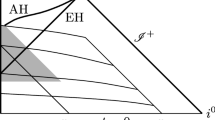Summary
The deformation shape of the liquid-drop model of nuclear fission can be excellently represented by the Legendre-polynomial expansion method. Unfortunately, in the past, it has appeared necessary to include a large number of higher-order terms in order to describe the more deformed shapes encountered in the later stages of fission. In this paper, we classify the degenerate singularity that occurs in the Businaro-Gallone-Swiatecki representation of the Legendre-polynomial expansion of the deformation shape for the slightly distorted ground state. In our analysis, we found the singularity to be double-degenerate and strongly 3-determinate. As a result, we have classified it as a hyperbolic-umbilic elementary catastrophe. In order to make the potential function of the singularity a universal unfolding, we introduced two new control parameters for the liquid-drop model.
Riassunto
La deformazione del modello a goccia di liquido della fissione nucleare si può rappresentare in modo eccellente con il metodo di sviluppo in polinomi di Legendre. Sfortunatamente in passato era sembrato necessario includere un gran numero di termini d’ordine superiore per descrivere le maggiori deformazioni incontrate nelle ultime fasi della fissione. In questo lavoro si classifica la singolarità degenere che si presenta nella rappresentazione di Businaro-Gallone-Swiatecki dello sviluppo in polinomi di Legendre della deformazione per lo stato fondamentale leggermente distorto. In questa analisi si trova che la singolarità è doppiamente degenere e fortemente trideterminata. Come risultato, è stata classificata come catastrofe elementare a ombelico iperbolico. Per far sì che la funzione del potenziale della singolarità sia una distensione universale, sono stati introdotti due nuovi parametri di controllo per il modello a goccia di liquido.
Реэюме
Конфигурация деформации в модели жидкой капли для деления ядер может быть хорощо описана с помошью метода раэложения по полиномам Лежандра. К сожалению, раньще было необходимо включать больщое число членов высщих порядков, чтобы описать сильно деформированные ядра на последних стадиях деления. В зтой статье мы классифицируем вырожденную сингулярность, которая имеет место в представлении Бусинаро-Галлоне-С виатецкого раэложения по полиномам Лежандра конфигурации деформации для слегка искаженного основного состояния. В предложенном аналиэе мы находим, что сингулярность является дважды вырожденной и 3-определенной. В реэультате зтого мы классифицируем зту сингулярность как гиперболическую омбилическую злементарную катастрофу. Чтобы сделать потенциальную функцию сингулярности универсальной раэверткой, мы вводим два новых контролируюших параметра в модель жидкой капли.
Similar content being viewed by others
References
N. Bohr andJ. A. Wheeler:Phys. Rev.,56, 426 (1939).
R. A. Brown andL. E. Scriven:Proc. R. Soc. London Ser. A,371, 331 (1980).
D. L. Hill andJ. A. Wheeler:Phys. Rev.,89, 1192 (1953).
A. Bohr andB. R. Mottelson:Annu. Rev. Nucl. Sci.,23, 363 (1973).
U. L. Businaro andS. Gallone:Nuovo Cimento,1, 1277 (1955).
U. L. Businaro andS. Gallone:Nuovo Cimento,1, 629 (1955).
U. L. Businaro andS. Gallone:Nuovo Cimento,1, 315 (1956).
S. Cohen andW. J. Swiatecki:Ann. Phys. (N. Y.),19, 67 (1962).
D. C. Hoffman andM. M. Hoffman:Annu. Rev. Nucl. Sci.,24, 151 (1974).
J. R. Nix:Annu. Rev. Nucl. Sci.,22, 65 (1972).
J. R. Nix:Annu. Rev. Nucl. Sci.,41, 52 (1967).
R. D. Present, F. Reines andJ. K. Knipp:Phys. Rev.,57, 731, 1188 (1940).
R. D. Present, F. Reines andJ. K. Knipp:Phys. Rev.,70, 557 (1946).
R. Vandenbosch:Annu. Rev. Nucl. Sci.,27, 1 (1977).
W. J. Swiatecki:Phys. Rev.,104, 993 (1956).
R. Thom:Structural Stability and Morphogensis (Reading, Mass., 1975).
T. Poston andI. N. Stewart,Catastrophe Theory and Its Applications (New York, N. Y., 1978).
G. Wasserman:Lecture Notes in Mathematics, Vol. 393 (New York, N. Y., 1974).
E. C. Zeeman:Lecture Notes in Methematics, Vol. 525 (New York, N. Y., 1976), p. 374.
T. Poston andI. N. Stewart:Taylor Expansions and Catastrophes (London, 1976).
S. Frankel andN. Metropolis:Phys. Rev.,72, 914 (1947).
Y. Lu:Singularity Theory and an Introduction to Catastrophe Theory (New York, N. Y., 1976).
Author information
Authors and Affiliations
Rights and permissions
About this article
Cite this article
Alesso, H.P., Smith, C.F. On classifying the singularity in the deformation shape of the liquid-drop model. Nuov Cim A 66, 272–282 (1981). https://doi.org/10.1007/BF02731688
Received:
Published:
Issue Date:
DOI: https://doi.org/10.1007/BF02731688



